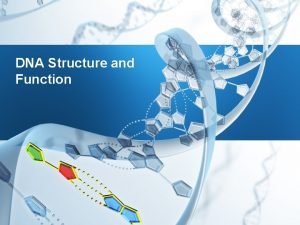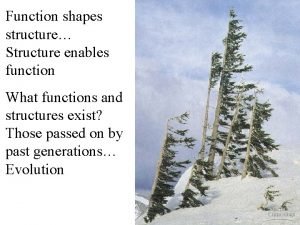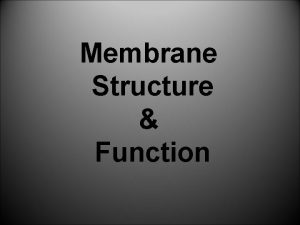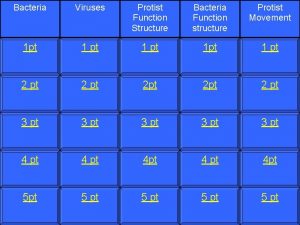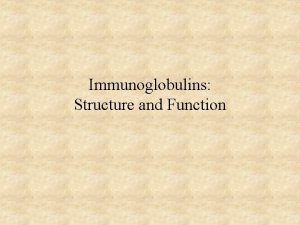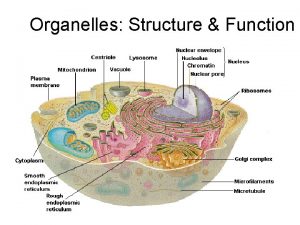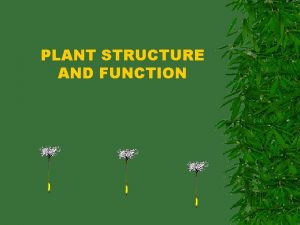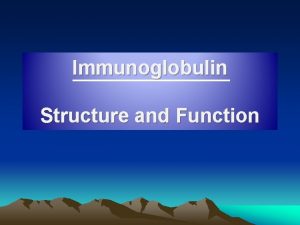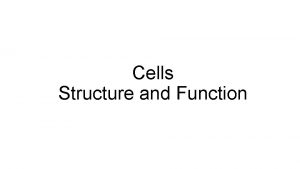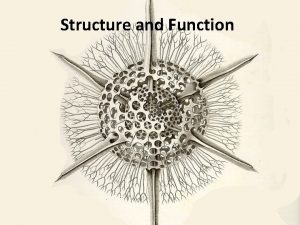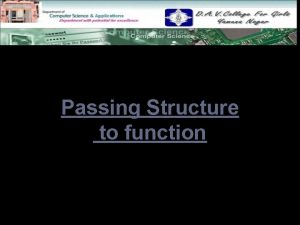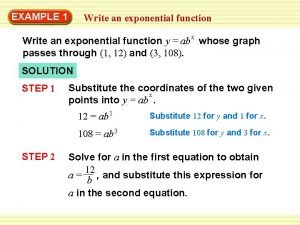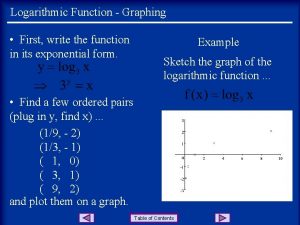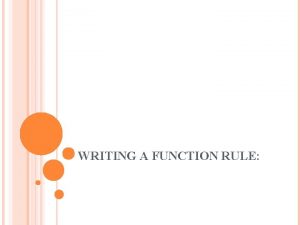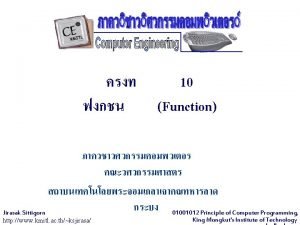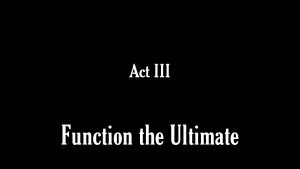Structure Function Write the structure function for the










































































- Slides: 74

Structure Function Write the structure function for the block diagram below. Identify minimum path vectors. 1 2 3 (X) 1 2 000 001 010 011 100 101 110 111 0 1 0 1 1 1 3 (X) = x 1 x 2 + x 3 - x 1 x 2 x 3 d = abc + a. Bc + Abc = (a+A)bc + a. Bc = (b + a. B)c 1 rd D = ab. C + a. BC + Ab. C + ABc + ABC = b. C + BC + ABc = C + ABc 12/14/2021

Exponential Function (CFR) 1. Write the density function: f(t) = e- t, t 0 2. Write E(T)? 1/ = MTTF 3. Write the failure rate. 4. Write the reliability function. R(t) = e- t = 1 – F(t) 5. Write the hazard function. h(t) = f(t)/R(t) = (CFR). 6. What property does #5 invoke? Memoryless Lack of memory” means the probability of failure in a specific time interval is the same regardless of the starting point of that time interval. 2 rd 12/14/2021

Example a) Find the probability of an item surviving until t = 100 units if the item is exponentially distributed with = 1/80. R(100) = e-100/80 = 0. 2865 b) Given that the item survived 200 units, what is the probability of survival until t = 300 units? What is the value of the hazard function at 200 units? at 300 units? P(T > 300|T > 200) = P(100) = 0. 2865 h(t) = = 1/80 = 0. 0125 For f(t) = e- t, t 0; 3 rd 12/14/2021

Systems Reliability Given 5 components connected in series with respective probabilities [0. 94 0. 87 0. 91 0. 89 0. 90], specify which component to improve to enhance the system reliability. T or F System reliability for series connected components is always greater than its least reliable component. T or F System reliability RS = P( (X) = 1) = E[ (X)] Give an example of a standby system. Spare tire 4 rd 12/14/2021

Path Vector Technique Find (X) for the bock diagram using path vector techniques. 1 2 1 3 2 3 (X) = 1 – (1 – X 1 X 2)(1 – X 1 X 3)(1 – X 2 X 3) The 4 path vectors are (1 1 0) (1 0 1) (0 1 1) (1 1 1) R(p)=E[ (X)] = [p 1 p 2(1 -p 3) + p 1(1 -p 2)p 3 + (1 -p 1)p 2 p 3) + p 1 p 2 p 3 = p 1 p 2 + p 1 p 3 + p 2 p 3 – 2 p 1 p 2 p 3 R = 1 - (1 - 0. 95 * 0. 95)3 = 0. 999073 5 rd 12/14/2021

Simulation Two independent constant failure rates = 1 and = ½ per month are connected in parallel. Find 10 th percentile, mean lifetime and probability of failure within a month. (percentile 10 (mapcar #' max (sim-exponential 1 10000) (simexponential 1/2 10000))) 0. 548 month vs. 0. 5442658 theoretical (mu (mapcar #' max (sim-exponential 1 10000) (sim-exponential 1/2 10000))) 2. 318 months is mean lifetime. 1/ 1 + 1/ 2 - 1/( 1 + 2) = 7/3 (count-if #'(lambda (x) (< x 1)) (mapcar #' max (sim-exponential 1 10000) (sim-exponential 1/2 10000))) 2509 => 0. 25 theoretical 1 R(t) = e-1 + e-1/2 - e-1 * e-1/2 = 0. 7513 1/2 6 rd 12/14/2021

Continued 1/ 1 + 1/ 2 - 1/( 1 + 2) 1 + 2 - 2/3 = 7/3 = 2. 333 1 – R(t) = F(t) = 1 – (e-1 + e-1/2 - e-1 * e-1/2) = 0. 1 and solve for t for 10 th percentile. Let y = e-t/2 => 1 – y 2 - y + y 3 - 0. 1 = 0 or (cubic 1 -1 -1 0. 9) (1. 212593 0. 761753 -0. 974346) e-t/2 = 0. 761753 => t = 0. 5442658 7 rd 12/14/2021

Survivor and Hazard Functions Given the density function f(t) = 2 e-2 t, find the survivor and hazard lifetime distributions. 8 rd 12/14/2021

Decomposition Find system reliability of network. Assume Ri = 0. 95 A C E B decompose with E working and E not working D RS = [2(0. 95) – 0. 952]2 0. 95 + [2 *0. 952 – 0. 954] 0. 05 = 0. 9452559375 + 0. 0497503125 = 0. 99500625 9 rd 12/14/2021

BRIDGE 1 4, 2 5, 1 3 5, 2 3 4 with 's = 1 with RS =0. 99981 for t = 1 hours. 1 4 3 2 10 rd 5 5 12/14/2021

Systems Engineering and Analysis Chapter 13 Design for Maintainability 11 rd 12/14/2021

OBJECTIVES LEARNING 12 AFTER STUDYING THIS CHAPTER, YOU SHOULD BE ABLE TO: Define and Explain maintainability; Use Measures of maintainability – elapsed times, frequencies, labor hours, costs; Apply availability and effectiveness factors Apply maintainability in the life-cycle – allocation, component selection, design participation, design review Apply maintainability analysis methods – trade-offs, level of repair analysis (LORA), maintenance task analysis (MTA) and total productive maintenance (TPM) rd 12/14/2021

Maintainability The relative ease and economy of time and resources with which an item can be retained in, or restored to, a specified condition when maintenance is performed by personnel having specified skill levels, using prescribed procedures and resources, at each prescribed level of maintenance and repair. A function of design Effective, Safe, ASAP, Least cost Minimum support (people, material, test equipment, facilities) Maintainability – design dependent parameter, kept in good condition, elapsed times, costs, frequencies 13 rd 12/14/2021

Maintainability & Maintenance Maintainability ~ ability of system to be maintained must be inherent or built into the design Maintenance ~ series of actions taken to restore or retain a system in specified state. Fix it. Is the result of the design. 14 rd 12/14/2021

Maintainability Design for maintainability requires a product that is serviceable (must be easily repaired) and supportable (must be cost-effectively kept in or restored to a usable condition) - better yet if the design includes reliability (absence of failures) Design for maintainability defines how long equipment will be down and unavailable. H(t) = 1 – R(t) = 1 – e- t = F(t) = P(T < t) for exponentially distributed repair times. 15 rd 12/14/2021

Constant Failure Rate Suppose a component can be repaired at a constant rate of 12 per 8 -hour day. Find the probability that the time to fix one exceeds 2 hours. H(t) = 1 – R(t) = 1 – e-t/MTTF => P(T > 2) = 1 – H(t) = e-2/(2/3) = e-3 = 0. 049787. 16 rd 12/14/2021

Maintainability and Reliability Inherent Availability = Ai = MTBF/(MTBF + MTTR) Operational Availability = Ao = MTBM/(MTBM + MDT) Achieved Availability Bar) 17 rd = AA = MTBM/(MTBM + M- 12/14/2021

Measures of Maintainability Corrective maintenance – restore system Preventive maintenance – scheduled maintenance to retain system in working order Adaptive maintenance – software Perfective maintenance – enhance software Downtime Mean Corrective Maintenance Time (Mct) or MTTR Failure detection, fault isolation, disassembly to gain access, repair. Active or maintenance times. Mean Active Corrective Maintenance Time (Mct) Mean Active Preventive Maintenance Time (Mpt) Availability = MTBF / (MTBF + Mct) 18 rd 12/14/2021

Corrective Maintenance Times (setf Table 13. 1 '( 40 58 43 45 63 83 75 66 93 92 71 52 55 64 37 62 72 97 76 75 75 64 48 39 69 71 46 59 68 64 67 41 54 30 53 48 83 33 50 63 86 74 51 72 87 37 57 59 65 63)) (mu-std-err table 13. 1) (61. 9, 16. 296) (histogram table 13. 1 7) 5 in (59/2 79/2) (* * *) 7 in (79/2 99/2) (* * * *) 10 in (99/2 119/2) (* * *) 12 in (119/2 139/2) (* * * *) 9 in (139/2 159/2) (* * * * *) z = (40 – 61. 9)/16. 3) = -1. 34 4 in (159/2 179/2) (* * * *) z = (50 – 61. 9)/16. 3) = -0. 73 3 in (179/2 199/2) (* * *) (del-phi -1. 34 -0. 73) 0. 1426 (del-normal 61. 9 (square 16. 296) 40 50) 0. 1431 or 50*0. 1431 7 (del-normal 61. 9 (square 16. 296) 46 78) 0. 6738 or 50*0. 6738 34 19 rd 12/14/2021

Corrective Maintenance Times 20 rd 12/14/2021

Stem and Leaf of Maintenance Times Cum Stem Leaf N = 50 5 3 03779 12 4 0135688 22 5 0123457899 34 6 233344456789 43 7 112245556 47 8 3367 50 9 237 Z 40 = (40 – 61. 9)/16. 3 = -1. 34 (phi -1. 34) 0. 09 (inv-phi 0. 09) -1. 34 (mu-std-err table 13. 1) Mct = 61. 9; σ = 16. 3) 21 rd 12/14/2021

Standard Z-Scores for Mcti -1. 357528 1. 307938 0. 564087 6. 198663 e-3 0. 812037 0. 564087 0. 316137 -0. 861627 1. 4939 -1. 543491 22 rd -0. 241752 0. 812037 -0. 613677 0. 626074 0. 130174 -0. 985603 -1. 29554 1. 307938 0. 75005 -0. 303739 -1. 171565 0. 254149 - 0. 427714 2. 175764 -0. 861627 -0. 179764 -0. 489702 -1. 791441 -0. 675665 -0. 179764 -1. 04759 1. 927814 0. 130174 0. 874025 -1. 419516 0. 378124 -1. 977404 -0. 737652 0. 626074 0. 192161 0. 068186 1. 865826 -1. 543491 0. 812037 0. 440112 0. 130174 -0. 55169 0. 068186 1. 555888 0. 068186) 12/14/2021

Median Discrete population: If sample size is odd, the middle value of the sorted population is the median. If sample size is even, the mean of the two middle values is the median. Example: (sort '(10 13 2 2 13 2 1 16 9 18) #' <) (1 2 2 2 9 10 13 13 16 18) => 9. 5 is the median Continuous distribution: Integrate up to the median for 50% probability Example: Find the median for f(x) = 2 x on [0, 1]. 23 rd 12/14/2021

Availability Inherent – excludes preventive, scheduled maintenance, logistics delay, admin delay. Ai is the largest availability value. Inherent Ai = MTBF (MTBF + Achieved Aa = MTBM (MTBM + ) includes Mpreventive Operational Ao = MTBM (MTBM + MDT) MDT = mean maintenance downtime = MTTR. = Mean active maintenance time. = mean active corrective maintenance time 24 rd 12/14/2021

Operational Availability is given by If the failure rate is 0. 01 failure per hour and the mean-timeto-repair (MTTR or MDT) distribution is continuous uniform on [2, 8] hours, find the system availability. Given: MTBF = 1/0. 01 = 100; E(MDT) = (2 + 8)/2 = 5 A = 100/(100 + 5) = 0. 95238 25 rd 12/14/2021

Incorrect Specifications The system shall have an operational availability of 0. 995 with a MTBF of 500 hours and a MDT of 6 hours. A = 500/(500 + 6) = 0. 9881 < 0. 995 (specified) conflicting specs 26 rd 12/14/2021

Repairable Systems Non-repairables – such as light bulbs Three models of Repair Replacement model – new item replaces a failed item Maintenance model – preventive maintenance Repair model – repaired before returning to service. Examples: "socket" model, how many bulbs to retain or redundancy allocation problem Replacement (? ) when to replace? failure? age? block? 27 rd 12/14/2021

Maintenance Models Preventive Maintenance - action taken before an item fails Examples: change oil in car, overhaul jet engine, lubricate a bearing Corrective Maintenance – action taken upon failure Examples: charging a dead car battery, repairing a failed printed circuit board in disc drive; fixing a flat. What is optimal time for preventive maintenance? Satellite repair is too costly to use preventive maintenance. 28 rd 12/14/2021

Failure and Repair Process Point Process Model X(t) = 0 if item failed at time t and = 1 if item is working at time t. x X 1 o R 1 x X 2 o R 2 x X 3 o R 3 x X 4 o R 4 Xi = ith time to failure and Ri the ith time to repair. x ~ failure times; o ~ time when repaired and returned to service 29 rd 12/14/2021

Point Process Poisson Process ~ when time to repair or replace is negligible compared to uptime. For example, when car is in shop an hour for an oil change (pit stop with no miles accrued) vs. an aircraft in a hangar for months having engines overhauled. Applicable to queue arrivals, earthquakes, crime, strikes, bankruptcies, wars, accidents. The s for an auto are many; for a light bulb is few. 30 rd 12/14/2021

Non-repairable vs. Repairable Non-repairable Item gets better with time Burn-in Item gets worse with time Wear-out Repairable Improving Deteriorating Stationary processes (Poisson) vs. independent increments 31 rd 12/14/2021

Partitioning Availability Time to detect failure Time to diagnose the problem Time to obtain parts and labor Repair time 0 1 Testing time 32 rd 12/14/2021

Queuing Model Breakdowns occur on average at 2 per day (Poisson) and each can be repaired at an average of 1/3 day (exponential). At a FCFS, what is the average number of items down at any time and the average waiting time before maintenance crew can begin service? = 2/3 L = /(- 1 ) = (2/3)/(1/3) = 2 items Wq = / ( - ) = 2/3(3 -2) = 2/3 day (MM 1 2 3) 33 rd 12/14/2021

Failure Rate = number of failures = N operating time TT – Not-time 50 artificial heart valves were tested for 10, 000 hours at a lab and 3 failed. a. What was the failure rate in %? b. number of failures per unit year? c. How many are expected to fail during a year from putting the valves into 100 patients? d. Find the MTBF. a) 3/50 = 6% b) 3/(10000*50 - 3*5, 000) = 0. 000006186/hr; assuming 3 failures occurred at average of 5, 000 hours. 0. 05418/yr c) 0. 05418 * 100 = 5. 42 d) MTBF = 18. 46 unit-yr/failure 34 rd 12/14/2021

Log-normal Log-Normal Cumulative distribution function Erf (x) = (- (* 2 (phi (* x (sqrt 2)))) 1)) 35 rd 12/14/2021

Maintenance Times Mean Preventive Maintenance Time (MT) M-barpt Median Active Corrective MT (Mct) Median Active Preventive MT (Mpt ) Mean Active MT M-bar Maximum Active Corrective MT (Mmax) Logistics Delay Time (LDT) Administrative Delay Time (ADT) (strikes, reassignments) Maintenance Downtime (MDT) total downtime 36 rd 12/14/2021

Maintenance Labor Hours MLH/OH MLH/cycle MLH/month MLH/MA 37 rd 12/14/2021

Maintenance Frequency Factors MTBM ~ mean time between maintenance a b MTBM = 1 1/MTBMa + 1/MTBMb MTBR ~ mean time between replacement 38 rd 12/14/2021

Maintenance Cost Factors Cost per maintenance action ($/MA) Maintenance cost per system operating hour ($/OH) Maintenance cost per month ($/month) Maintenance cost per mission segment ($/mission) The ratio of maintenance cost to actual life cycle cost 39 rd 12/14/2021

System Effectiveness (SE) Probability that system performs as intended Cost Effectiveness (CE) cycle cost System benefits / life. System capacity / life-cycle cost SE / life-cycle cost Availability / life-cycle cost Supportability / life-cycle cost 40 rd MTBM MTBR M-bar Mpt MLH/OH $/MA 12/14/2021

Maintainability Allocation Suppose inherent availability probability = 0. 9989 with MTBF = 450 hours; MLH/OH = 0. 2; Mct = ? Mct = MTBF(1 – Ai) / Ai = 450 (1 – 0. 9989) / 0. 9989 = 0. 5 hours allocated to the components. continued 41 rd 12/14/2021

Maintainability Allocation Item Q Failure-rate Cf Cp Mct Ct = Cf. Mct Unit A 1 0. 246 11% 0. 9 0. 221 Unit B 1 1. 866 84% 0. 4 0. 746 Unit C 1 0. 110 5% 1. 0 0. 110 2. 222 100% Total 1. 077 Mct for System = 1. 077 / 2. 222 = 0. 485 hr (0. 5 hr needed) Unit B's 0. 4 hours is allocated to its components. Cc contribution of total corrective maintenance times 42 rd 12/14/2021

Demonstration Method I 1. Failure is induced with only naturally occurring evidence 2. Technician called in to repair. 3. Repairs in approved way 4. Data is collected on all operations to note delays, inadequacies, shortages, performance, test procedure. The test is repeated on n simulated failures and an example of the allocation is shown in Table 13. 14. 43 rd 12/14/2021

Demonstration 2 Given maintenance times, find M-bar, M-barct M-barpt Mmax Upper limit = M-barct + z / (sqrt n) 44 rd 12/14/2021

P 13 -27 = 3105/50 = 62. 1 < 65 V( ) = 15, 016/50 = 300. 32 Mct = 62. 1 + 1. 645 * 17. 33/7. 07 = 66. 1 > 65 => Reject at 5%; OK at 20% Specs: Mbar = 75 min Mbar-ct = 65 min Task Mcti Variance 1 58 16 2 72 100 3 32 900 … … … Total 3, 105 15, 016 Mbar-pt = 110 min Mmax = 120 min Producer's risk ( ) = 5% 45 rd 12/14/2021

P 13 -7 With availability set at 0. 990 and a calculated MTBF of 400 hours, find the mean corrective maintenance time Mct = MTBF(1 – Ai) / Ai = 400(1 – 0. 99) / 0. 99 = 4. 04 hours 46 rd 12/14/2021

P 13 -8 Determine Given Ai MTBM = 0. 004 Aa MTBF TOT = 10 K hrs Ap M-bar MDT = 50 hr Mbarct MTTRg TNo. MA = 50 M-barp = 6 hr Mean logistics + admin = 30 hr 47 rd Solutions-Answers MTBF = 1/ = 250 hrs Mbar = 50 – 30 = 20 hrs 10 K * 0. 004 = 40 => 10 = PM 20 = Mbarct *. 004+6*. 001/. 005 Mbarct = 23. 5 hrs MTBM = 10000/ 50 = 200 hrs Ai = 250/(250+23. 5) = 0. 9141 Aa = 200/(200+20) = 0. 9091 A 0 = 200/(200+50) = 0. 8 12/14/2021

P 13 -11 Item Q Contribution % Contribution Mct * Cf = Q Cp =Cf/Sum Contribution (minutes) A 1 0. 05 0. 07 2 1. 00 B 2 0. 16 0. 32 0. 42 0. 6 0. 192 C 1 0. 27 0. 35 0. 9 0. 243 D 1 0. 12 0. 16 1. 5 0. 180 0. 76 1. 00 Total 0. 715 M-barct = 0. 715/0. 760 = 0. 94 < 1 hr assigned to ABC => some relaxing * Estimated times from inherent characteristics of design 48 rd 12/14/2021

P 13 -25 (setf p 13 -25 '(39 57 70 51 74 63 66 42 85 75 42 43 54 65 47 40 53 32 50 73 64 82 36 63 68 70 52 48 86 36 74 67 71 96 45 58 82 32 56 58 92 91 75 74 67 73 49 62 64 62)) (mu-std-err p 13 -25) (61. 48 16. 25) H 0: 65 vs. H 1: < 65 with = 10%, n = 50, s = 16. 25 X-bar = 61. 48 Z = 7. 07(61. 48 – 65)/16. 25 = -1. 53 < -1. 288 p-value = 0. 0628 < = 10%, => Reject 49 rd 12/14/2021

Unit B Allocation Item Q F-rate Cf 1 1 0. 116 2 1 1. 550 3 1 0. 200 Total Cp Mct Ci = Cf. Mct 6% 0. 5 0. 058 1. 550 83% 0. 4 0. 620 0. 200 11% 0. 3 0. 060 1. 866 100% 0. 738 Mct for Unit B = 0. 738 / 1. 866 = 0. 395 hr (0. 4 hr needed) 50 rd 12/14/2021

Component Selection and Application Use standardized components (COTs); standard tools Built-in test (BITE) for quick, easy diagnostics for time consuming tests Ensure accessibility for remove and replace and modular independency Seek modular, physical and functional interchangeability of parts. Avoid preventive maintenance needs. Prioritize locations using time to repair and accessibility for high failure rate items or critical components Label components 51 rd 12/14/2021

Maintainability Analysis Tradeoff between reliability and maintainability -- Current need: 8 hrs daily operation, 360 days/yr for 10 years. Ai = 0. 961, MTBF = 125 hrs, Mct = 5 hrs New: Ai = 0. 990, MTBF > 300, Mct < 5 12 Configuration Ai MTBF Mct 10 Existing 0. 961 125 5. 0 8 A 0. 991 450 4. 0 6 B 0. 990 375 3. 5 4 C 0. 991 320 2. 8 2 Ai = MTBF/(MTBF + M-barct ) 52 rd Mct Ai = 0. 961 Existing design Ai = 0. 990 Trade-off Area Ai = 0. 995 0 200 300 400 600 800 1000 1200 MTBF Reliability MTBF, hr 12/14/2021

Prediction of Mct Table 13. 10 Maintainability Prediction Worksheet (Assembly i) Maintenance Times (Hr) Part N N Loc Iso Acc Ali Cck Int Mct N Mct A. 161 2. 322. 08. 14. 01. 11. 43 0. 138 B. 102 4. 408. 01. 05. 12. 01. 02. 12. 33 0. 134 C … Total Underlined constitute a maintenance cycle time 53 rd 12/14/2021

Maintainability Analysis Maintainability Prediction Reliability-Centered Maintenance (RCM) Level-of-Repair Analysis (LORA) – repair or replace Maintenance Task Analysis (MTA) – what's needed Total Productive Maintenance (TPM) Maintainability Demonstration – ORI Maintainability Assessment – of MTBM. MDT, MLH/OR 54 rd 12/14/2021

Downtime Logistics Delay Time (LDT) Administrative Delay Time (ADT) Maintenance Downtime (MDT) 55 rd 12/14/2021

Mean Corrective Maintenance Time = MTTR = 56 rd 12/14/2021

Mean Preventive Maintenance Time pt = fpi is the frequency of the ith preventive maintenance action per system operating hour Mpt is elapsed time needed for the ith action to exclude logistic delay and administrative delay times. 57 rd 12/14/2021

Median Active Corrective Maintenance Time = antilog 58 rd 12/14/2021

Median Active Preventive Maintenance Time 59 rd 12/14/2021

Mean Active Maintenance Time fpt is the preventive maintenance rate 60 rd 12/14/2021

Maximum Active Corrective Maintenance Time (Mmax) Mean of the logarithms of Mct; Z ~ to standard deviation, sample logarithms of average repair times 61 rd 12/14/2021

Total Productive Maintenance (TPM) Integrated life-cycle approach to maintaining a manufacturing plant Overall equipment effectiveness (OEE) OEE = availability (A) * performance rate (P) * quality rate (Q) Availability = loading time – downtime loading time Loading time – total time available to make products P = output * actual cycle time * ideal cycle time loading time – downtime actual cycle time Q = [input – (quality defects + startup defects + rework)] / input 62 rd 12/14/2021

Summary Maintainability Analysis Interrelationship of Maintainability with Reliability Systems Life-Cycle Approach 63 rd 12/14/2021

Problem 13 -5 ((41. 2) (39. 3) (47. 2) (35. 5) (23. 13) (27. 10) (33. 6) (17. 12) (19. 12) (37. 4) (25. 10) (36. 5) (31. 7) (13. 3) (11. 2) (15. 8) (29. 8)(21 14) (2 3 2 5 13 10 6 12 12 4 10 5 7 3 2 8 8 14) (41 39 47 35 23 27 33 17 19 37 25 36 31 13 11 15 29 21) Range = 47 – 11 = 36 (setf P 13 -5 (flatten (mapcar #' list-of '(2 3 2 5 13 10 6 12 12 4 10 5 7 3 2 8 8 14) '(41 39 47 35 23 27 33 17 19 37 25 36 31 13 11 15 29 21)))) (11 11 13 13 13 15 15 17 17 17 19 19 19 21 21 21 21 23 23 23 23 25 25 25 27 27 27 29 29 31 31 33 33 33 35 35 35 36 36 36 37 37 39 39 39 41 41 47 47) (Range P 13 -5) 36; 64 rd 12/14/2021

(Histogram P 13 -5 9 ) Problem 13 -5 histogram N = 126 13 in (21/2 31/2) (* * * *) 24 in (31/2 41/2) (* * * * * * *) 37 in (41/2 51/2) (* * * * * * * * * *) 18 in (51/2 61/2) (* * * * *) 18 in (61/2 71/2) (* * * * *) 12 in (71/2 81/2) (* * * *) 2 in (81/2 91/2) (* *) 2 in (91/2 101/2) (* *) 0 in (101/2 111/2) Log Normal Distribution (skewed right) (mu-std-err p 13 -5) (25. 15 7. 82) (median p 13 -5) 23 (mu-std-err (mapcar #' log p 13 -5)) (3. 17643 0. 315509) * Using Log Base e (geometric-mean P 13 -5) 23. 961 (exp (mu (mapcar #' log p 13 -5))) 23. 961 = Mct = Geometric Mean (std-err (mapcar #' log p 13 -5 (list-of 126 10))) 0. 137024 * Using Log base 10 Mmax = antilog (1. 3795 + 1. 2817 * 0. 138) where 1. 38 is (antilog 23. 961 and = antilog 1. 55638 1. 2817 is (inv-phi 90) and = 36 minutes 1. 3795 is 23. 961 antilog 23. 961 65 rd 12/14/2021

Problem 13 -6 (setf P 13 -6 (flatten (mapcar #' list-of '(2 6 2 4 1 10 3 6 12 10 12 13 8 3 3 1 ) '(35 17 12 15 37 27 33 31 25 19 21 23 29 13 9))) (35 35 17 17 17 12 12 15 15 37 27 27 27 33 33 33 31 31 31 25 25 25 19 19 19 21 21 21 23 23 23 23 29 29 13 13 13 9) The boundaries of the class intervals are: 6 in (17/2 27/2) 10 in (27/2 37/2) 35 in (37/2 47/2) 22 in (47/2 57/2) 17 in (57/2 67/2) 3 in (67/2 77/2) (* * * *) NORMAL (* * *) Appearing (* * * * * * * * *) (* * * * * *) (* * * * *) (* * *) (range p 13 -6) 28; (mu-std-err p 13 -6) (23. 32258 5. 778824) 66 rd 12/14/2021

Problem 13 -7 With a specified inherent availability of 0. 99 and a calculated MTBF of 400 hours, find the mean corrective maintenance time. Mct = MTBF(1 - Ai)/Ai = 400(1 – 0. 99)/0. 99 = 4. 04 hours 67 rd 12/14/2021

Problem 13 -8 Given = 0. 004, total operation time = 10, 000 hours, Mean downtime = 50 hours, Total number of maintenance actions = 50 and mean preventive maintenance time = 6 hours, and mean logistics plus administrative = 30, find a) MTBF = 1/0. 004 = 250 hours b) M-bar = 50 – 30 = 20 hours (assumption) 68 rd 12/14/2021

Problem 13 -9 Given Mct = 0. 5 hour; MTBMa = 2 hours Mpt = 2 hours; MTBMs = 1000 hours; compute the achieved availability. 1 MTBM = 1/MTBMa + 1/MTBMs = 1/(1/2 + 1/1000) = 1. 996 hours = 0. 5 and frequency of preventive fpt = 0. 001 M-bar = (0. 5 * 0. 5 + 0. 001 * 2)/(00. 5 + 0. 001) [See 13. 8] = 0. 504 hours Aa = MTBM/(MTBM + M-bar) = 1. 966/(1. 966 + 0. 504) = 0. 796 69 rd 12/14/2021

Problem 13 -12 System operates 40 hours per week for 50 weeks a year for 15 years. MTBF is 400 hours and mean corrective time is 2 hours. Two techs are assigned for the duration of each maintenance action. Find the MLH/OH. (40 * 50 * 15)/400 = 30, 000/400 = 75 maintenance actions. 75 * 2 hours * 2 techs = 300 MLH/30, 000 OH = 0. 01 MLH/OH 70 rd 12/14/2021

P 13 -26 Mpt = 120 minutes required. (setf p 13 -26 '(150 120 133 92 89 115 122 69 172 161 144 133 121 101 114 112 181 78 112 91 82 131 122 159 135 108 95 67 118 103 78 93 144 152 136 86 113 102 65 113 101 94 129 148 118 102 106 117 115)) (mu-std-err p 13 -26) (115. 14 26. 68) Z = H 0: 120 vs. H 1: < 120 with = 10%, n = 50, s = 26. 68, X-bar = 115. 14 => Xcritical = 120 - 1. 28 * 26. 68/7. 07 = 115. 17; (inv-phi 0. 10) -1. 28 Z = 7. 071(115. 17 – 120)/26. 68 = -1. 288 < -1. 281729 => p-value = 0. 098873 => Reject 115. 14 + 1. 28 * 26. 68 / 7. 07 = 119. 97 < 120 => Passed Test (depict p 13 -26) 71 rd 12/14/2021

P 13 -27 = 3105/50 = 62. 1 < 65 V( ) = 15, 016/50 = 300. 32 Mct = 62. 1 + 1. 645 * 17. 33/7. 07 = 66. 1 > 65 => Reject at 5%; OK at 20% Specs: Mbar = 75 min Mbar-ct = 65 min Task Mcti Variance 1 58 16 2 72 100 3 32 900 … … … Total 3, 105 15, 016 Mbar-pt = 110 min Mmax = 120 min Producer's risk ( ) = 5% 72 rd 12/14/2021

Reliability of a System Compute reliability of system. Compute reliability if system redundancy is used. Ans. 0. 8370, 0. 9737 0. 95 73 rd 0. 98 0. 90 12/14/2021

Preventive Maintenance Policy Find expected number of breakdowns (bds). Each bd cost $280. For a cost of $150/month, a firm guarantees 1 bd/month. Is this a good deal? Σ # of breakdowns 0 1 2 3 4 10 # months (freq) 2 8 10 3 1 24 probability 1/12 1/3 5/12 1/8 1/24 E(bds) = 1. 71 => costing 1. 71 * $280 $479 (wo contract) 150 + 280 = $430 (w contract) $ 49/month (EV '(1/12 1/3 5/12 1/8 1/24) (upt 0 4)) 1. 7083 74 rd 12/14/2021
 Fspos vägledning för kontinuitetshantering
Fspos vägledning för kontinuitetshantering Novell typiska drag
Novell typiska drag Tack för att ni lyssnade bild
Tack för att ni lyssnade bild Ekologiskt fotavtryck
Ekologiskt fotavtryck Varför kallas perioden 1918-1939 för mellankrigstiden
Varför kallas perioden 1918-1939 för mellankrigstiden En lathund för arbete med kontinuitetshantering
En lathund för arbete med kontinuitetshantering Underlag för särskild löneskatt på pensionskostnader
Underlag för särskild löneskatt på pensionskostnader Personlig tidbok för yrkesförare
Personlig tidbok för yrkesförare Sura för anatom
Sura för anatom Vad är densitet
Vad är densitet Datorkunskap för nybörjare
Datorkunskap för nybörjare Tack för att ni lyssnade bild
Tack för att ni lyssnade bild Debattartikel struktur
Debattartikel struktur Magnetsjukhus
Magnetsjukhus Nyckelkompetenser för livslångt lärande
Nyckelkompetenser för livslångt lärande Påbyggnader för flakfordon
Påbyggnader för flakfordon Kraft per area
Kraft per area Offentlig förvaltning
Offentlig förvaltning Jag har gått inunder stjärnor text
Jag har gått inunder stjärnor text Presentera för publik crossboss
Presentera för publik crossboss Teckenspråk minoritetsspråk argument
Teckenspråk minoritetsspråk argument Vem räknas som jude
Vem räknas som jude Treserva lathund
Treserva lathund Epiteltyper
Epiteltyper Bästa kameran för astrofoto
Bästa kameran för astrofoto Cks
Cks Lågenergihus nyproduktion
Lågenergihus nyproduktion Bra mat för unga idrottare
Bra mat för unga idrottare Verktyg för automatisering av utbetalningar
Verktyg för automatisering av utbetalningar Rutin för avvikelsehantering
Rutin för avvikelsehantering Smärtskolan kunskap för livet
Smärtskolan kunskap för livet Ministerstyre för och nackdelar
Ministerstyre för och nackdelar Tack för att ni har lyssnat
Tack för att ni har lyssnat Vad är referatmarkeringar
Vad är referatmarkeringar Redogör för vad psykologi är
Redogör för vad psykologi är Matematisk modellering eksempel
Matematisk modellering eksempel Tack för att ni har lyssnat
Tack för att ni har lyssnat Borra hål för knoppar
Borra hål för knoppar Vilken grundregel finns det för tronföljden i sverige?
Vilken grundregel finns det för tronföljden i sverige? R formel
R formel Tack för att ni har lyssnat
Tack för att ni har lyssnat Rita perspektiv
Rita perspektiv Vad är verksamhetsanalys
Vad är verksamhetsanalys Tobinskatten för och nackdelar
Tobinskatten för och nackdelar Blomman för dagen drog
Blomman för dagen drog Mästar lärling modellen
Mästar lärling modellen Egg för emanuel
Egg för emanuel Elektronik för barn
Elektronik för barn Fredsgudinna
Fredsgudinna Strategi för svensk viltförvaltning
Strategi för svensk viltförvaltning Kung som dog 1611
Kung som dog 1611 Indikation för kejsarsnitt på moderns önskan
Indikation för kejsarsnitt på moderns önskan Sju för caesar
Sju för caesar Tack för att ni lyssnade
Tack för att ni lyssnade Mindre än tecken
Mindre än tecken Skriva i bunden form
Skriva i bunden form Inköpsprocessen steg för steg
Inköpsprocessen steg för steg Rbk-mätning
Rbk-mätning Ledarskapsteorier
Ledarskapsteorier Expektans eller exspektans
Expektans eller exspektans Myndigheten för delaktighet
Myndigheten för delaktighet Trög för kemist
Trög för kemist Tillitsbaserad ledning
Tillitsbaserad ledning Läkarutlåtande för livränta
Läkarutlåtande för livränta Punkthöjd karttecken
Punkthöjd karttecken Gumman cirkel
Gumman cirkel Vishnuismen
Vishnuismen Mitos steg
Mitos steg Bris för vuxna
Bris för vuxna Big brother rösta
Big brother rösta Write the function of ecf in the sdlc frame structure.
Write the function of ecf in the sdlc frame structure. Cache memory adalah
Cache memory adalah Hình ảnh bộ gõ cơ thể búng tay
Hình ảnh bộ gõ cơ thể búng tay Bổ thể
Bổ thể












































































